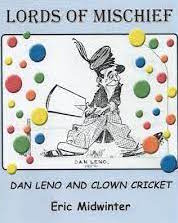Lords of Mischief
Archie Mac |Published: 2022
Pages: 165
Author: Midwinter, Eric
Publisher: Max Books
Rating: 4 stars

As author Eric Midwinter points out, ‘clown cricket’ has basically been shunned by cricket historians, with only the occasional passing mention. I have to admit, apart from knowing that the first great Yorkshire left arm off spinner – Edmund Peate – had played ‘clown cricket’, I had no real understanding of what it entailed or just how big it was throughout the 1860s to the 1880s.
There is a definite crossover between cricket and the theatre with ‘clown cricket’. Lords of Mischief attempts to cater for both sets of fans. No easy assignment as you don’t want to lose or annoy your readership by providing basic information which is common knowledge to the devotee of cricket or the theatre. Thankfully, we have an author who knows both subjects intimately. The fact that Eric Midwinter is one of the best authors period, equates to an excellent read. I am not sure about theatre fans, however as a cricket tragic, I thought Midwinter explained the theatre connection of ‘clown cricket’ admirably. I had no trouble following the acting or music hall stars or their trials and tribulations. In fact I spent a lot of time looking them up on Wikipedia to further my knowledge.
Perhaps more importantly for the readers of CricketWeb, Midwinter doesn’t go into too much basic explanation about cricket. In fact I was surprised how deftly he was able to explain things such as the Yorkshire hierarchy run by the iron fist of Lord Hawke. Or the importance to cricket lovers and statisticians of Arthur Haygarth, who was mostly dismissive of ‘clown cricket’, with rarely a mention in his seminal work – Scores and Biographies.
Lords of Mischief takes you right through the history and business of ‘clown cricket’. And it was definitely a money making business. It was heavily advertised in the newspapers as the troupes moved from town to town. The basic premise was that the clowns would play a local XI (which did not usually include any professionals), at cricket before putting on a show at night. This was a big production and involved a lot of support staff. At the cricket the clowns, in full costume, would entertain by doing somersaults, tricks and not always accepting the umpire’s decision, much to the merriment of the spectators.
Midwinter introduces us to some of the prominent clowns, starting with Harry Croueste, who appears to be one of the founders of ‘clown cricket’. Unfortunately at some point Croueste went broke and rivals took over his troupe of performers. The most famous ‘clown cricketer’ was Dan Leno, who was also a huge star of the theatre. The significant difference between Leno and the other ‘clown cricketers’ was that Leno performed for charity. He also resurrected ‘clown cricket’ long after it had stopped being a money making enterprise. Regrettably, just like almost everyone else we meet from the theatre, Leno had a sad demise at a relatively young age. One thing a number of cricketers and entertainers from the period appear to have in common is a fondness for alcohol, with mostly disastrous results.
Lords of Mischief – is a superbly produced and written book which fills a niche in the history of cricket literature. Hopefully with its crossover with the entertainment field it will appeal to a wide range of people. It certainly deserves to be read by a large audience.






Leave a comment